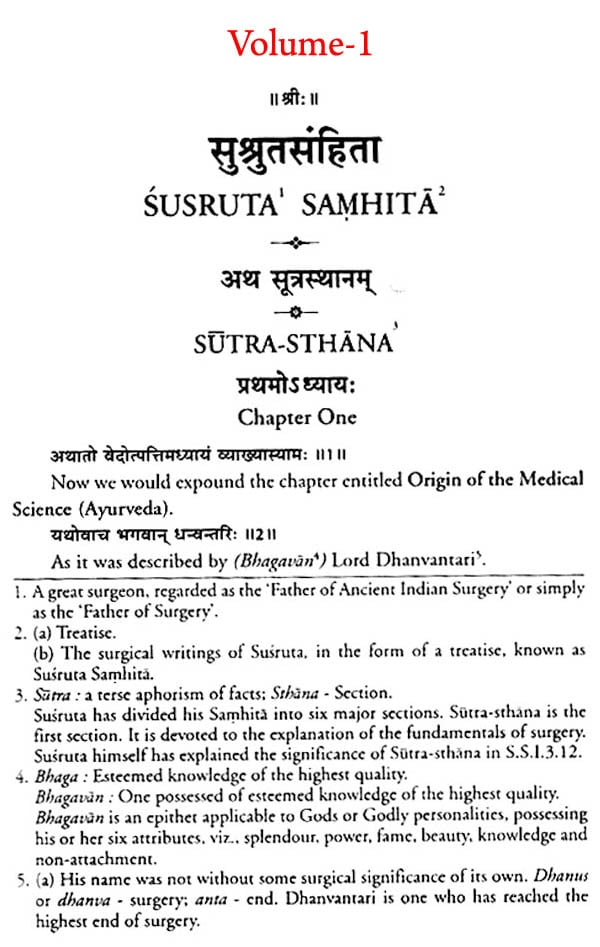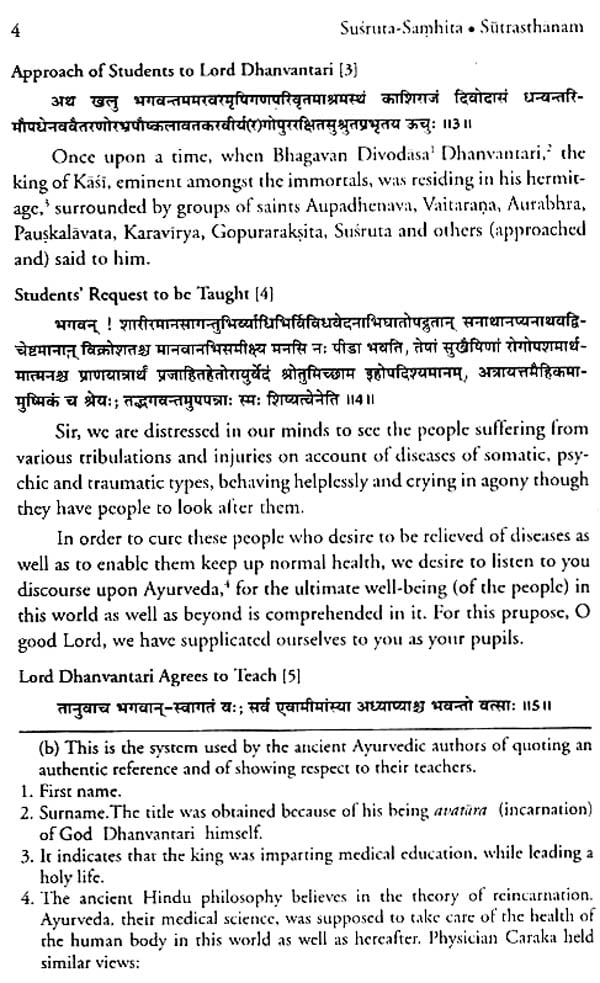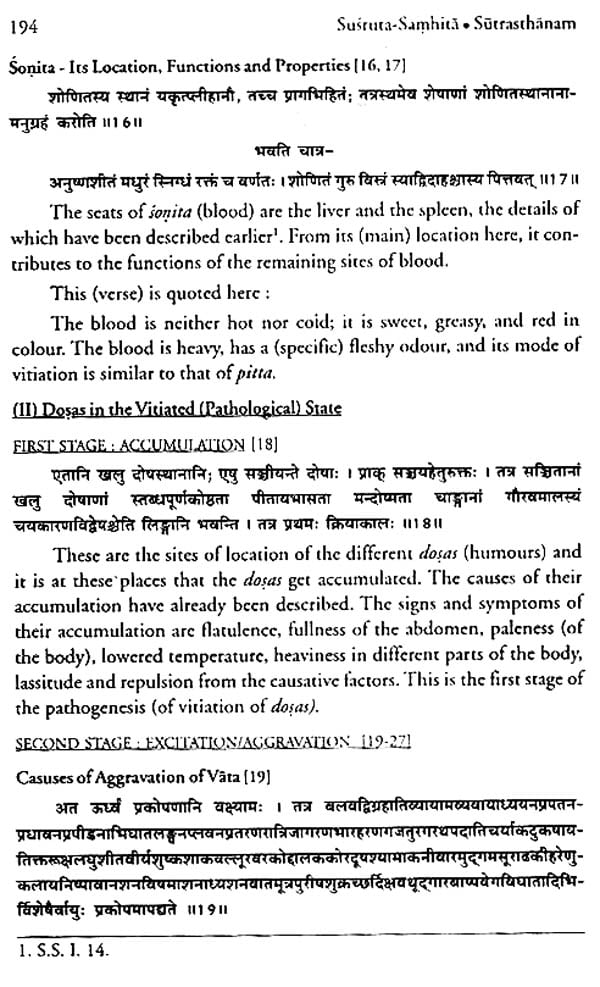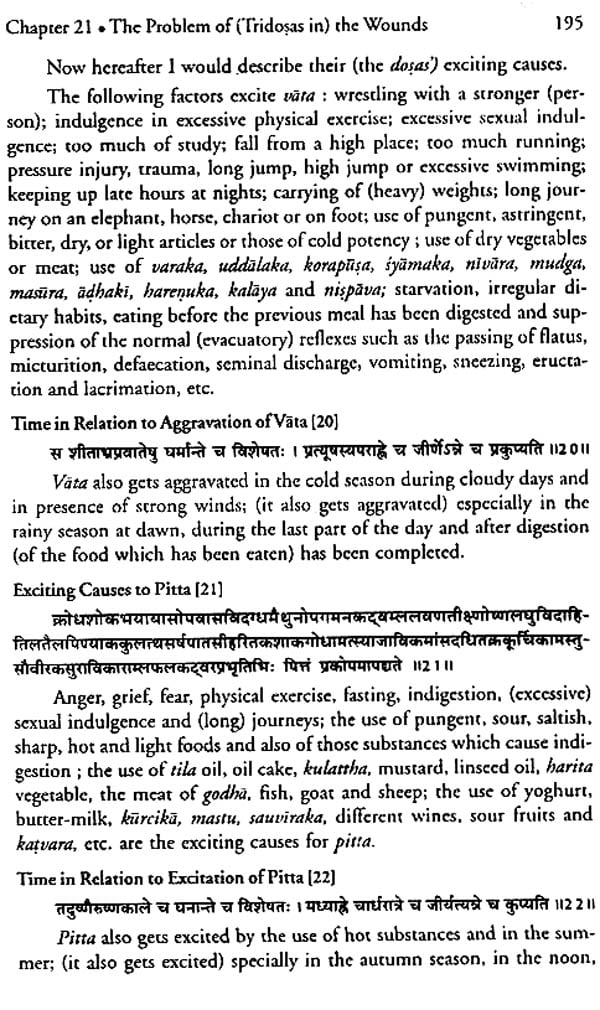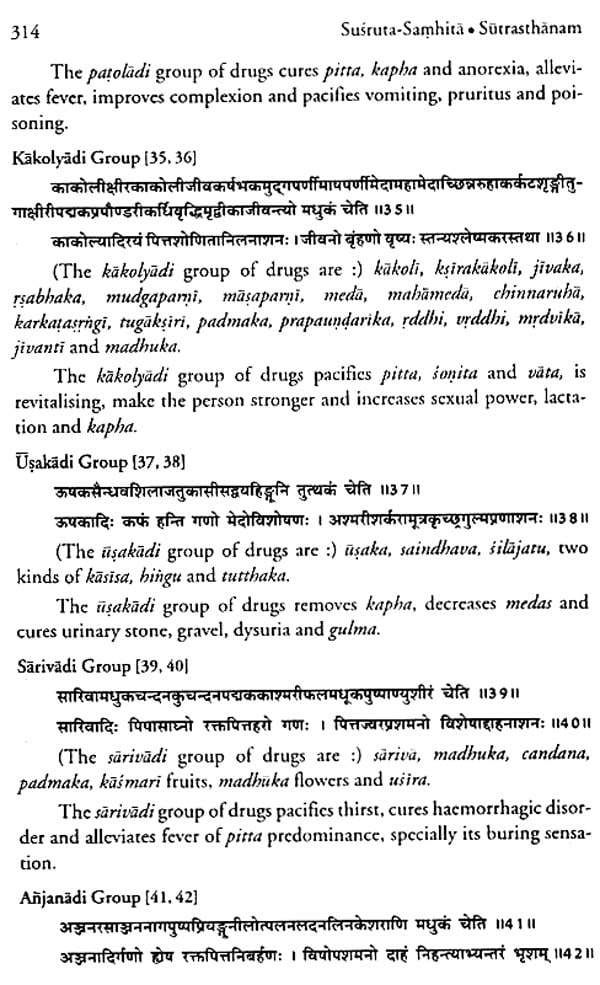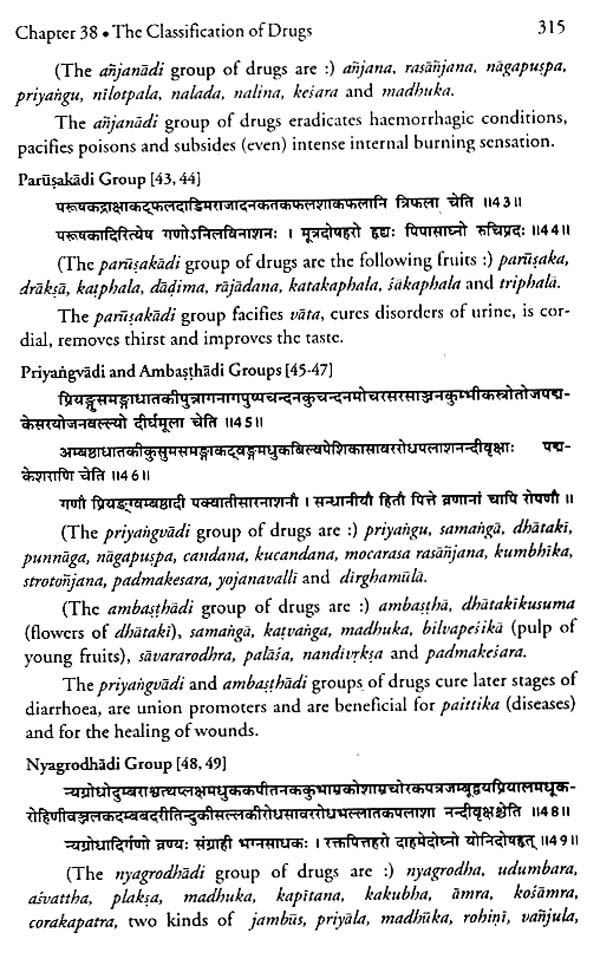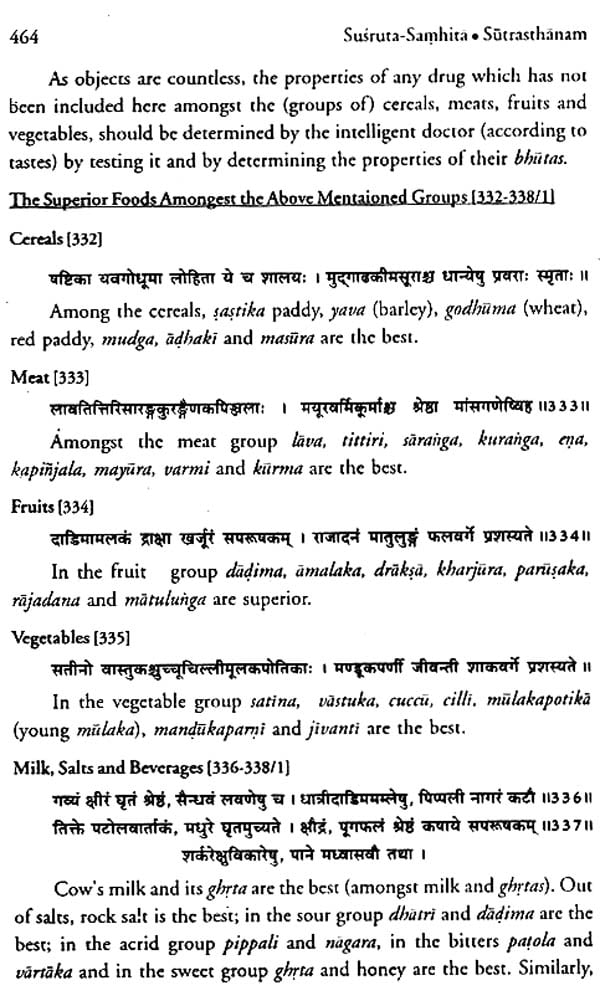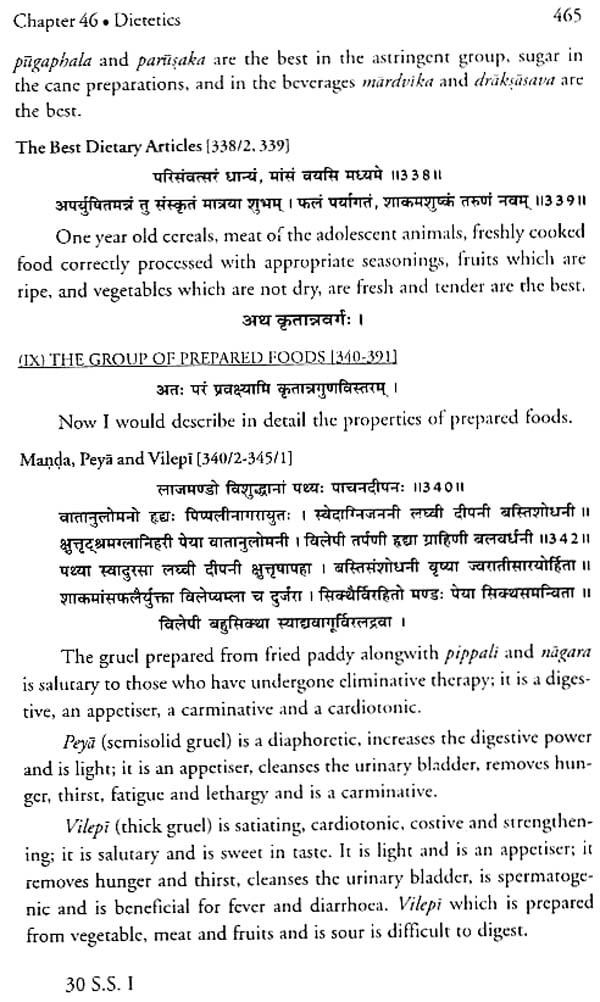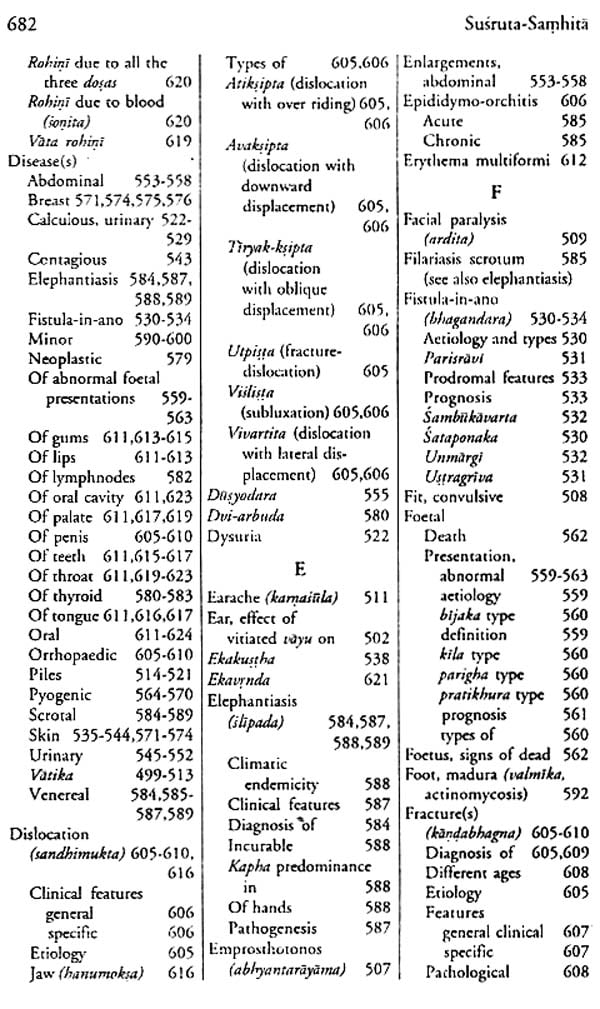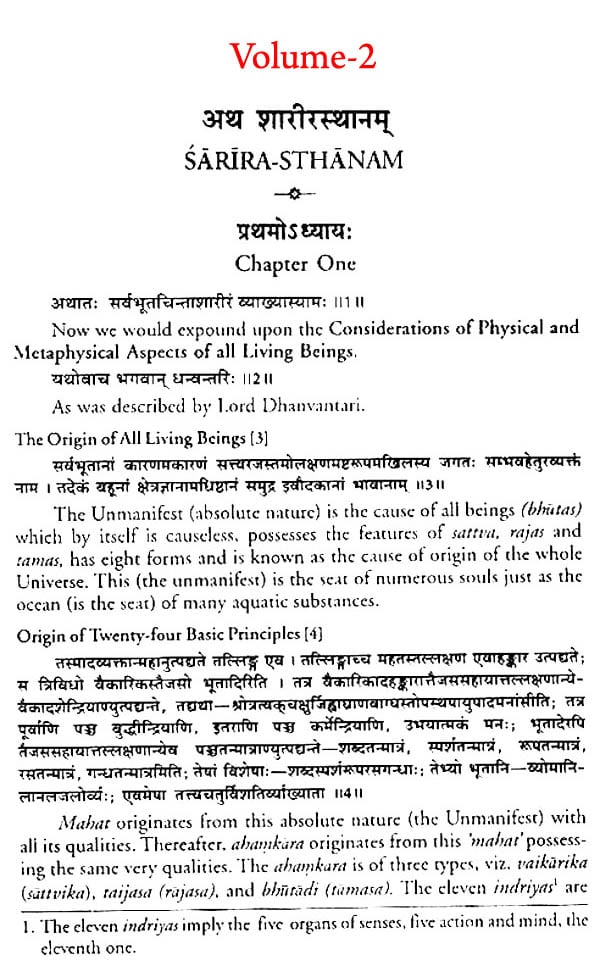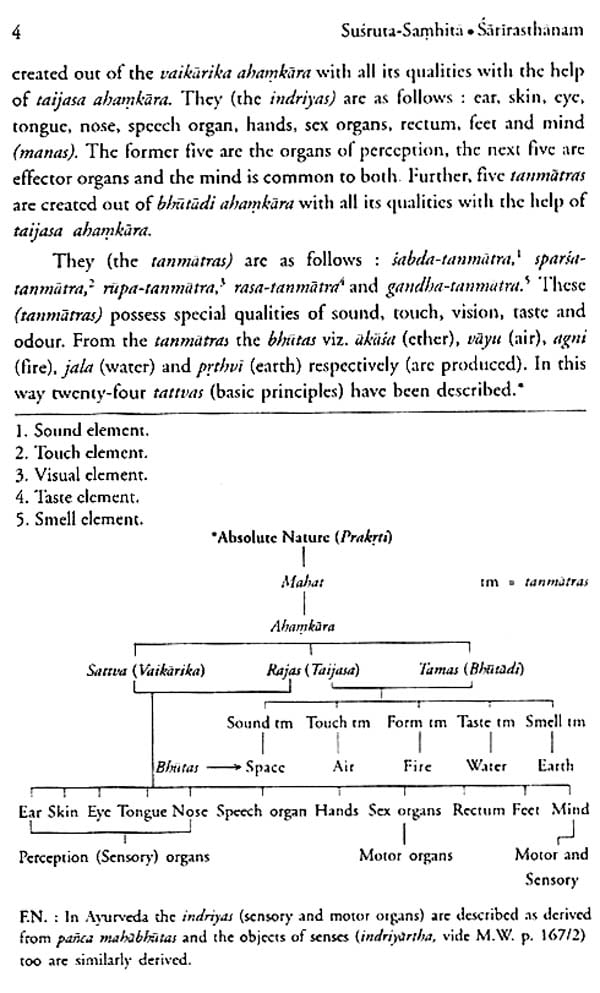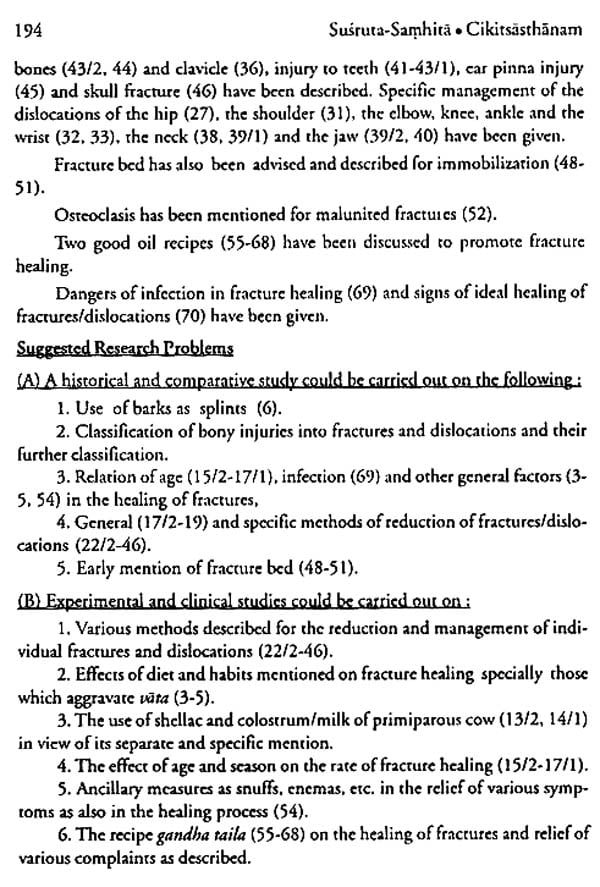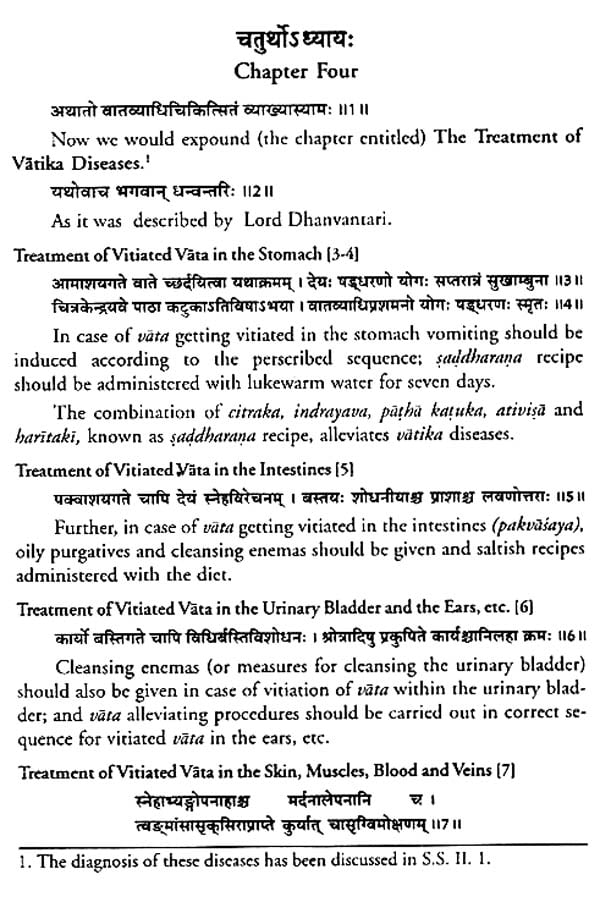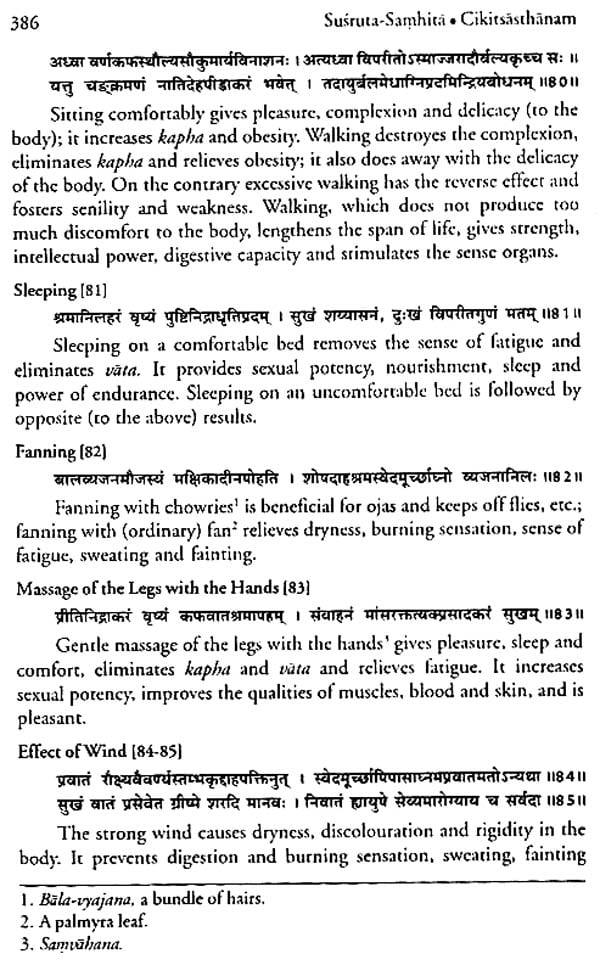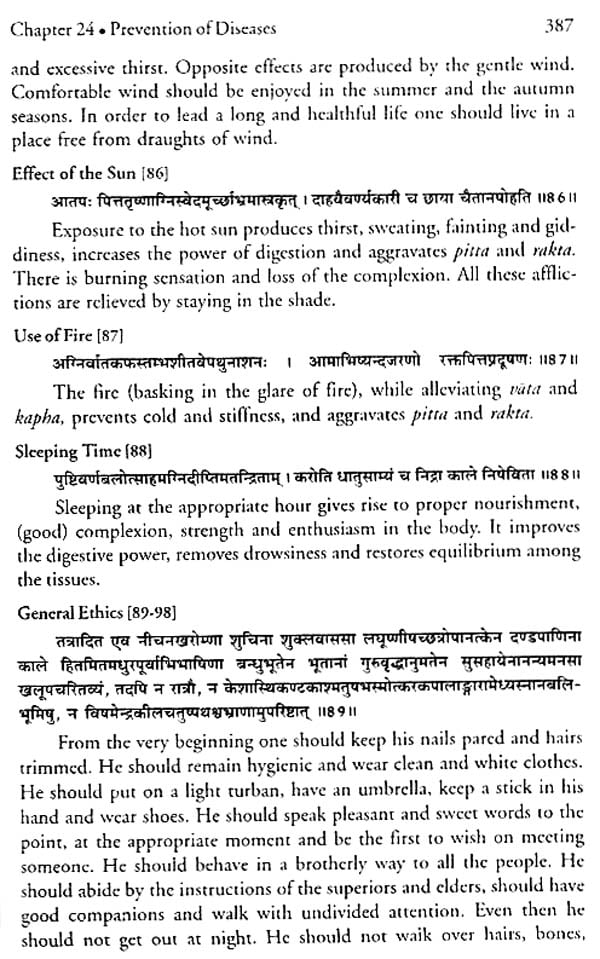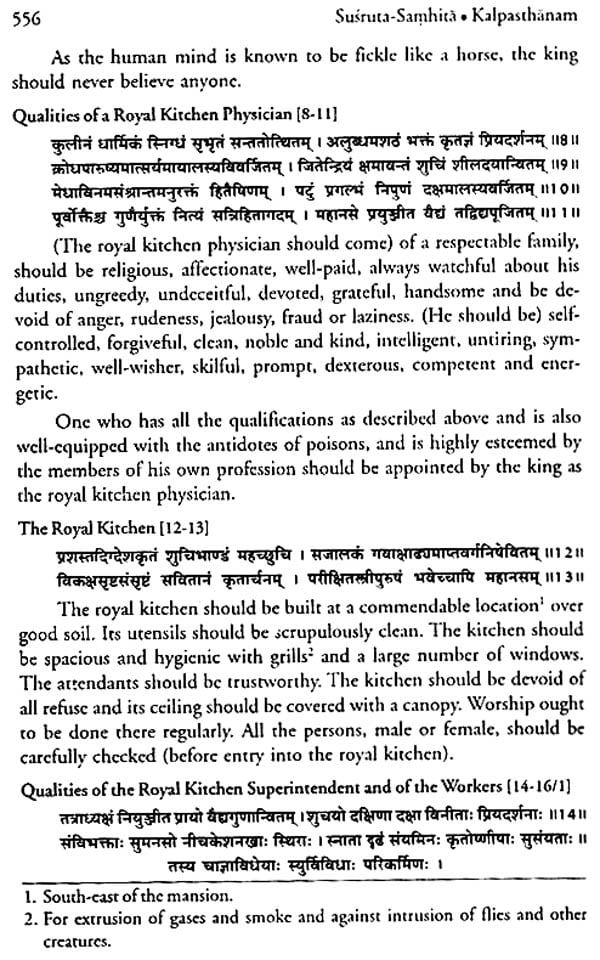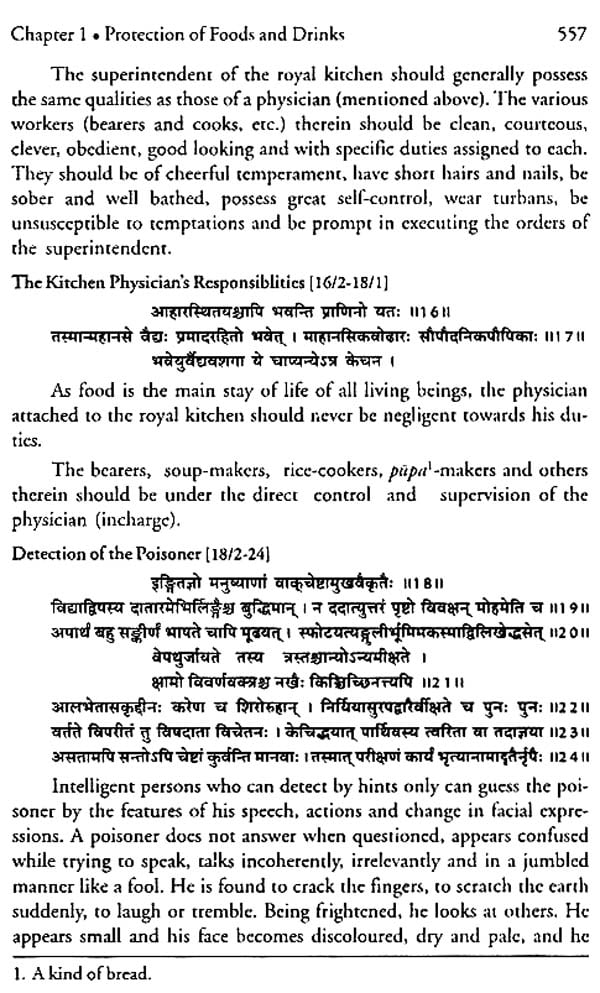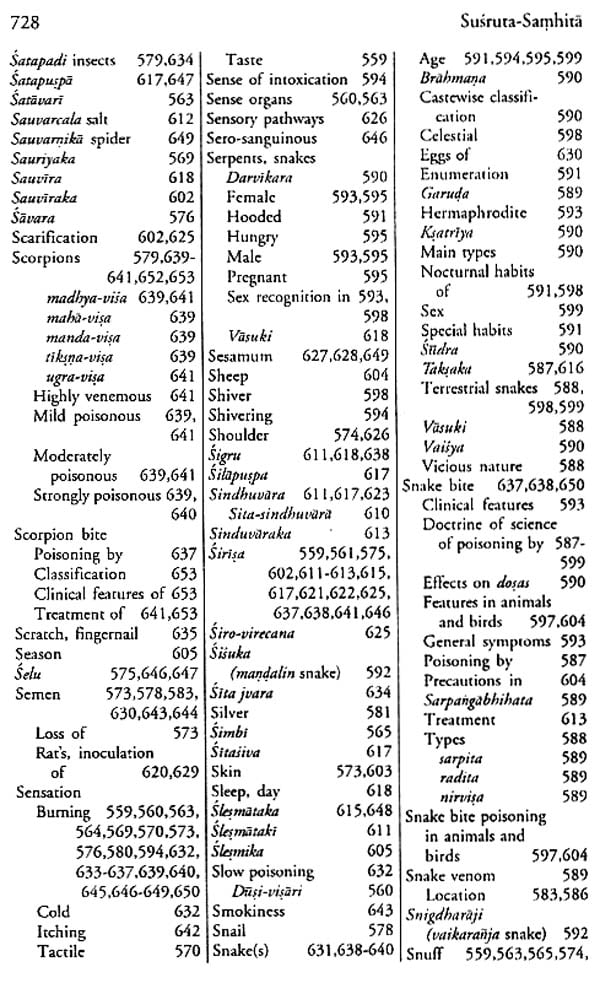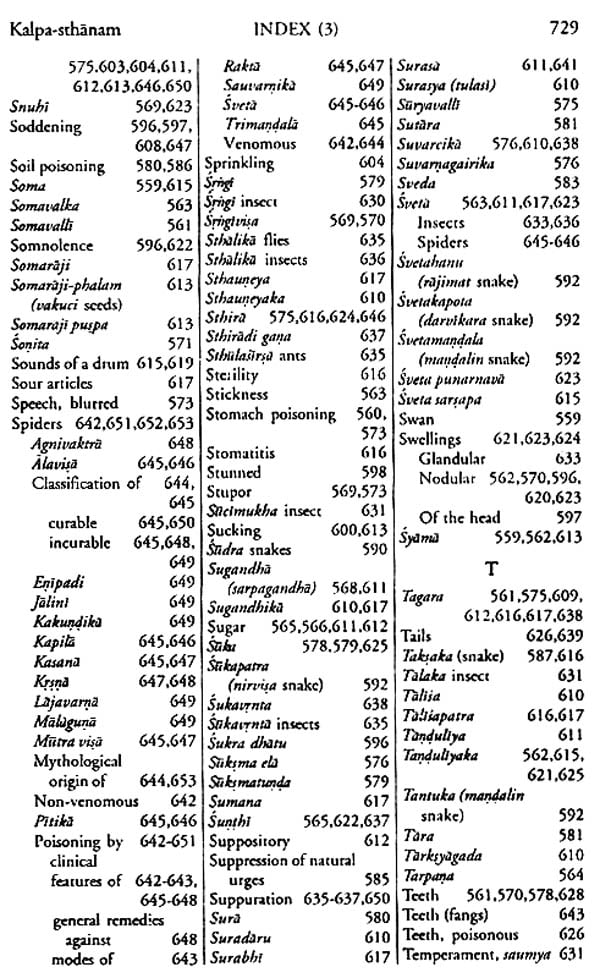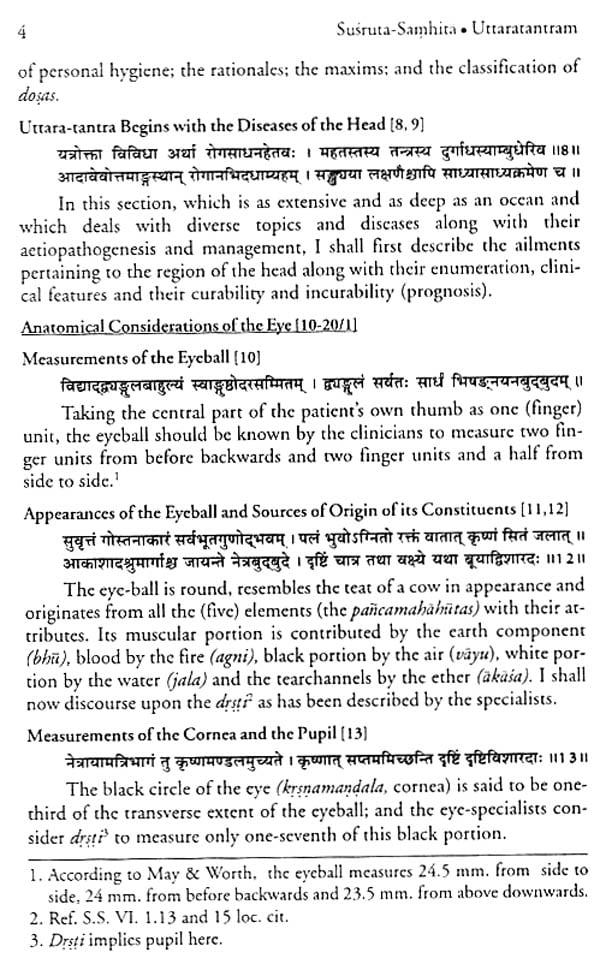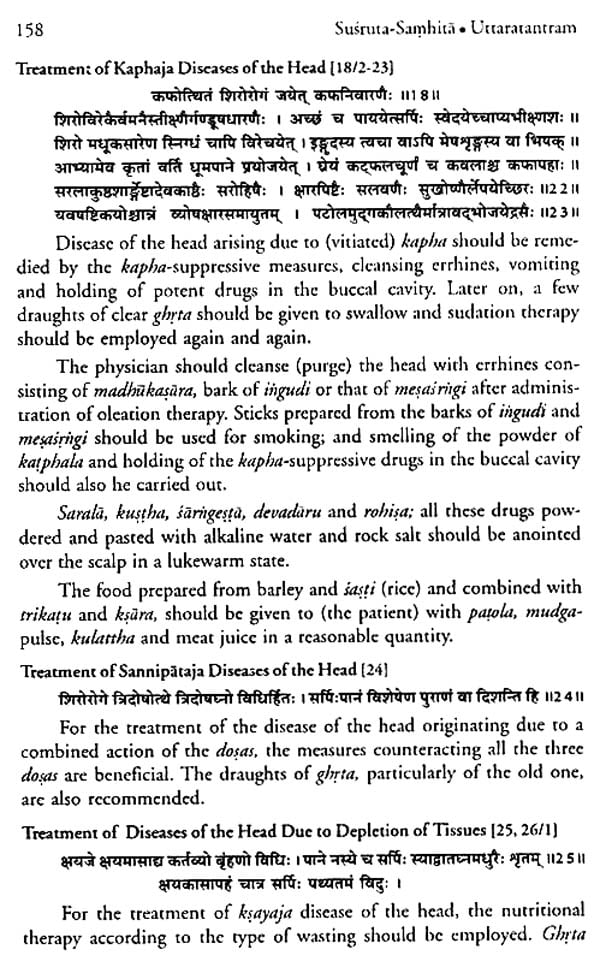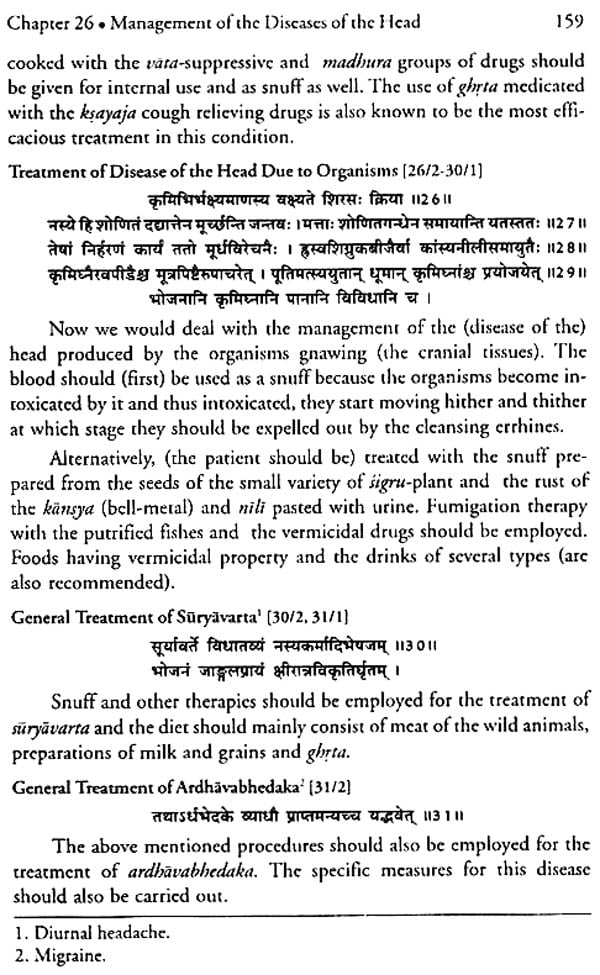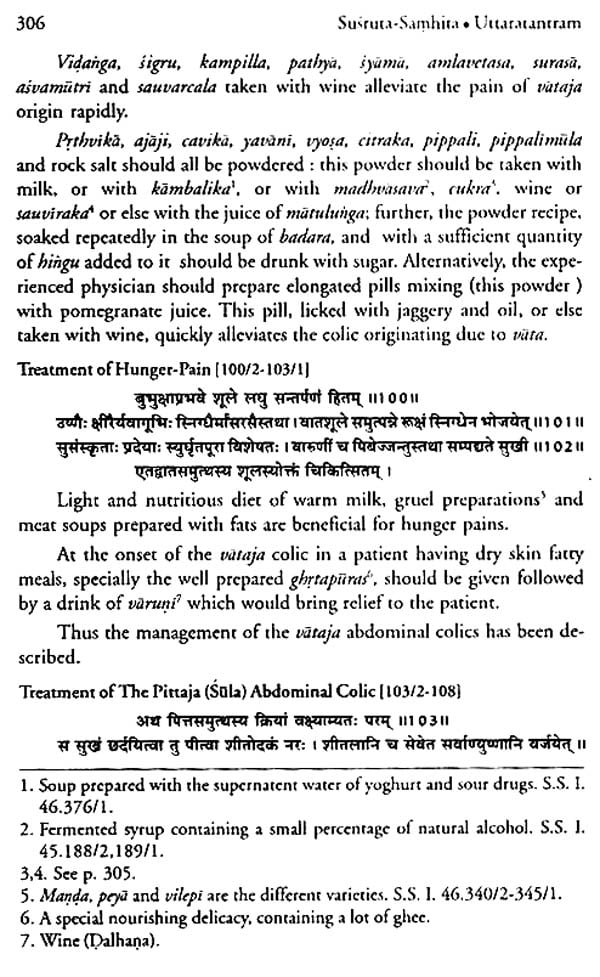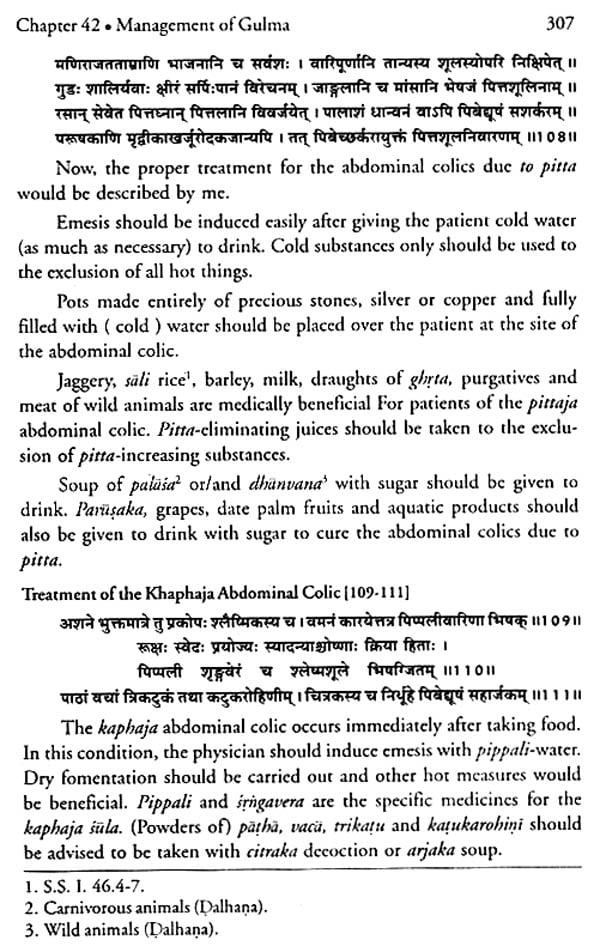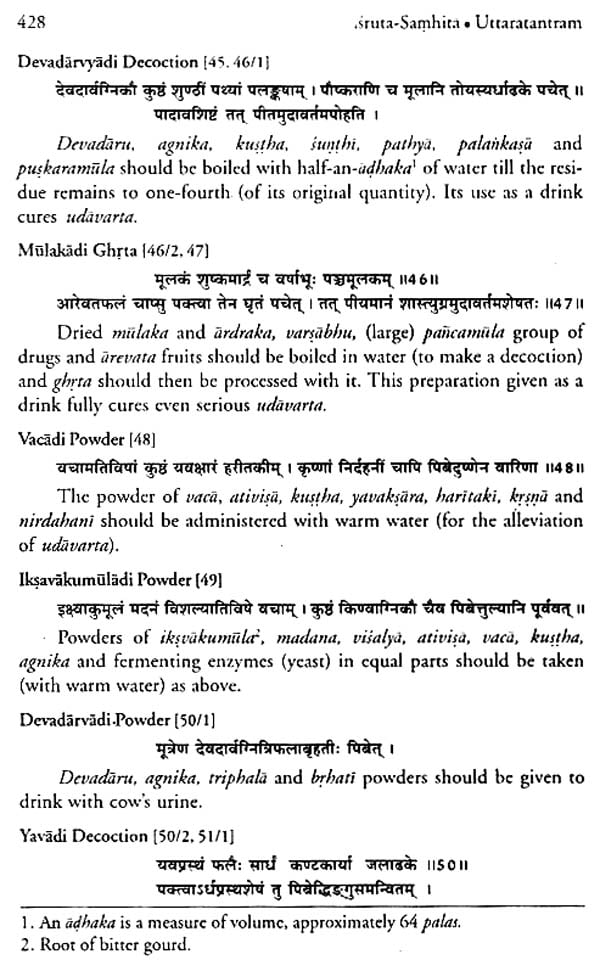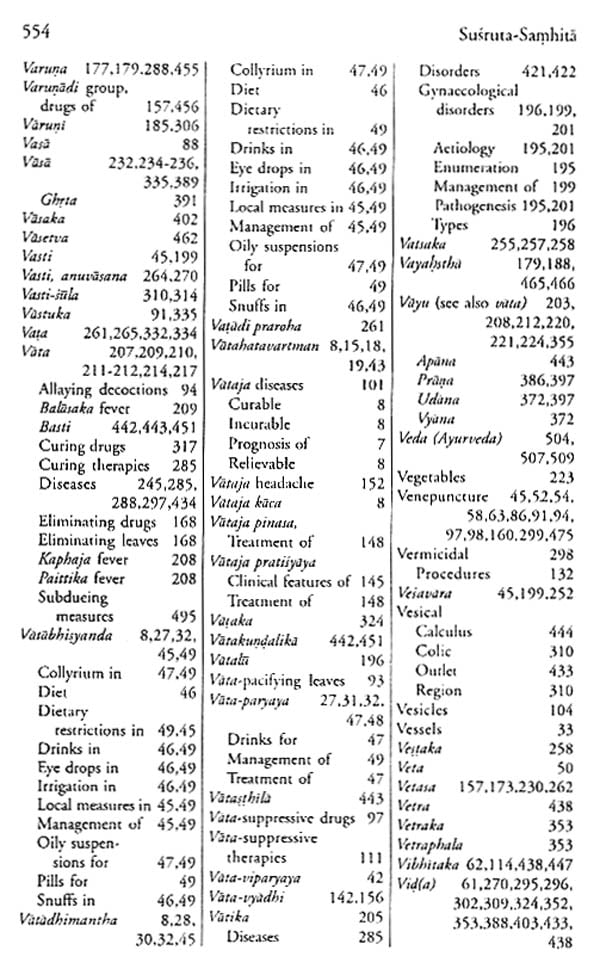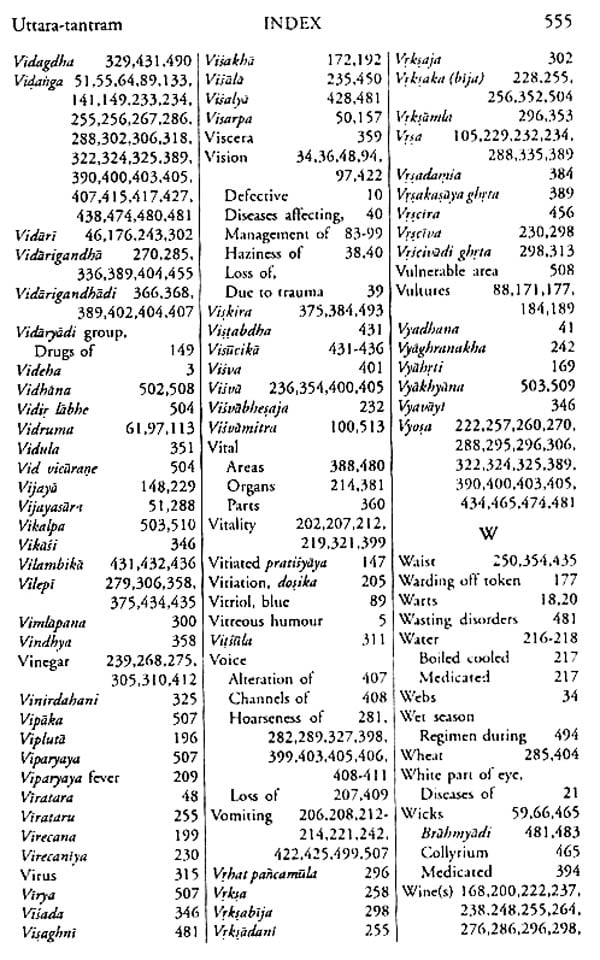
Susruta Samhita: Ancient Indian Surgery (3 Big Volumes)
Book Specification
| Item Code: | IDG232 |
| Author: | DR. G. D. SINGHAL & COLLEAGUES |
| Publisher: | Chaukhamba Sanskrit Pratishthan |
| Language: | English |
| Edition: | 2018 |
| ISBN: | 9788170846307 (Set) |
| Pages: | 1975 |
| Cover: | PAPERBACK |
| Other Details | 9.00 X 6.00 inch |
| Weight | 2.59 kg |
Book Description
Vaidyakirti (Honoris Causa, Sri Lanka) Born at Allahabad in 1932. Brilliant academic career with medical eduction at Lucknow, Edinburgh and Toronto. A widely travelled Paediatric Surgeon and Historian of Medicine, Rotarian Dr. Singhal was Professor & Head of the Paediatric Surgery Section and former Head of the Dept. of Surgery, Institute of Medical Sciences, Banaras Hindu University, Varanasi.
Prof. Singhal was a Fellow of the International Society of History of Medicine and was the President of the B.H.U. History of Medicine Society; he was also a Fellow/Member of many national/international academic bodies on Surgery/Paediatric Surgery/History of Medi- cine and was recognised as an authority on Ancient Indian Surgery. His monumetal ency- clopaedic Ayurvedic works on Sushruta Samhita and Madhava Nidana have already won national/international recognition are changing the History of Medicine and are stimulating research on Ayurveda all over the world. Prof. Singhal claimed Sushruta of India to be called the ‘Father of Surgery" and frequently invited to give authentic talks on the subject in India and abroad.
It is a great pleasure to introduce the English translation of Susruca Samhita being brought out under the editorship of Dr. G. D. Singhal. Susrura Samhica is one of the important treatises of Ayurveda and has a lot of valuable information among others from the surgical point of view. A diligent search of this treatise reveals the presence of seeds of conceptual thoughts relating to many surgical aspects which are practised in current period,
Ayurveda has been handed over from generation to gencration almost in an uninterrupted continuity. In Susruta Samhita one finds a systematised approach and the deeper understanding of this is likely to open new vistas of thought and the present English version is aimed to apprise the modern worker the intti- cacies present in this great treatise.
The editorial board while translating has also presented a picture of gen- esis of cach concept and its place in the current surgical practice can be easily appreciated through this. This will enable the reader to know its impact on the art and practice of surgery today.
The entire work is divided into various sections almost faithfully based on the original text. The sections purport to highlight the surgical aspects practised in those days with their relevance to the present day surgical methods, manouvers and knowledge.
Susruta was considered a surgeon and he belonged to Dhanwanrari school of thought. The evolution of a medical system was invariably preceded by cura- tive spells and other religious and traditional folk customs. Medical and surgical procedures written at that remote period cannot ignore these fundamental traits. Following this a system of medical practice with considerable refinement emerg: d and it did not fully shelve the magic spells and traditions into oblivion in view of their hold on society and life.
The wars, in ancient days, to some extent contributed for the development and progress of different branthes of medical knowledge including surgery. War surgery developed in this way. References to Vedic surgery like uniting che head of the God of sacrifice to his decapitated body provides insight into the surgical acumen that existed then. War free period provided scope for leading a peaceful and stately life during which men travelled in chariots and other kinds of ve- hicles for enjoyment and as a luxury in a carefree mannet and got involved in road accidents. This provided scope for the development of the surgery of acci- dents and injuries. Midwifery also developed since the war surgery had litde place in peace time. Evolution and advances of surgery, or as a matter of fact of any branch of knowledge, is with reference to needs, circumstances and environ- ment in addition to other factors connected with life. Susrutarin surgery almost followed Vedic surgery. The credit of providing a systematised approach goes to Susruta since he was the earliest to make elaborate efforts to keep it on a sound footing so far as his age is concerned in practice and of imparting practical knowledge. Instrumentology also developed during his time since this has a greater potential for success in this field. The plastic surgery and rhino-plasty described by Suiruta have been acclaimed even today as the greatest of the sur- gical techniques and they may be treated as important landmarks in the field of surgery. Obviously by advancement of this and other techniques the country sowed sceds for the development of a high class surgical approach of sophis- ticated nature. India made original contribution to the corpus of surgical knowledge. Reference to cataract crouching, amputation of limbs, abdominal operations, setting of fractures and dislocations, treatment of hacmorrhoids and fistula, treating of hernia, etc. and the basic principles behind these numerous operations which were described by Suéruta are as much valid today as it was then. Lithotomy and post-operative management of these cases are discussed in detail. A number of obstetrical manouvers and operative techniques have been elaborated. Ophthalmic surgery was practised in the days of Susruta. Practical training was considered essential and reference to methods to be adopted to provide effective practical knowledge in those days in surgical methods and techniques will be found to be interesting. Surgical incisions are practised on vegetables having different consistencies and textures; this provided a practical knowledge and experience regarding the force to be adopted, the extenvdepth to which the incisions were to be made in addition to making the surgical stu- dent steady. Another therapeutic measure mentioned was blood-letting.
With a view to provide the required knowledge. the treatise of Suiruta laid emphasis on a study of the anatomy and the dissection of cadavers. The work of Susruta dealt with cmbryology, biology. cosmogony, physiology, materia medica and therapeutics and a number of fields which have relevance to the study of Ayurveda. The medical aspect has also been mentioned by Susrura almost in the same manner though stress is laid on surgical aspects.
Susruta Samhita can be considered as an excellent surgical treatise which was much eulogised by a number of occidental and other experts.
With the availability of an English version with a detailed commentary and helpful notes, the treatise will benefit a wider circle of readers not only in India but also abroad with potentiality to contribute further in the art and practice of surgery. The planning of the work provides an advantage of a rapid reference to the subject/topic in which the reader is interested. The long felt need for such a work is expected to be solved by the series of volumes envisaged.
I have every confidence that this will prove to be a valuable addition to every medical institution whatever be the system it is handling. Research work- ers, scholars, teachers, surgical experts and scientists irrespective of the field of medicine to which they belong are sure to find the work useful and rewarding. The editorial board composed of experts of Ayurveda and allopathic system pro- vide an acceptable interpretation of the concepts and substance of Suéruta Samhita. The much felt need for an English version of Sugruca Samhiea having interpretative and working information will be met with by this compendium.
India has a great and ancient cultural heritage. Medical treatment (Ayurveda) flourished here centuries ago when people in other parts of the world were not so advanced. There is no dearth of evidence to prove these state- ments as is shown by the Vedas, Puranas and other subsequent Indian publica- tions.
Ayurveda, the ancient Indian system of medicine, was practised about 1000 B.C. It is available today in three classical Samhitas or treatises, the Caraka, Susrura and Vagbhata (in addition to many other smalicr later publications). All were written in Sanskrit, the ages old Indian language comparable to the Greek or Latin of the Wester World. Caraka and Vagbhata books are mainly on medicine whereas Suiruta is chiefly a surgical treatise.
As all these classical creatises have so far been available in Sanskrit only, they have been comparatively less well known to the modern world, A great necessity was felt to bring out the proud possessions of ours accepted as invaluable national literary treasures using contemporary scientific and medical terminology in a language understandable easily in many other parts of the world. Susruta, the surgical treatise has been selected to be brought our firse.
A great necessity has been felt by the scientists of the modern world, doc- tors, surgeons, historians, research workers and the educated class of public in general to be able ca get to know Suéruta-Samhitd in the language understand- able by them. English written in Roman script was selected as the language for translation as it is one of the international languages and myself and other authors and translators here have a working knowledge of it.
Other attempts at Translation and their Drawback The first accempt at cranslation of Suiruta-Samhitt was made in 1897 by Dr. A.ER. Hoernle, C.1.E. His preface is quoted verbatim below "The present translation of che Suruta-Samhité has been undertaken by me at the special request of the Council of the Asiatic Society of Bengal. The original translation made by Dr. Udoy Chand Dutt was stopped by the untimely death of the translator, after the publication of his second fasciculus. Its continuation by another translator proved so unsatisfactory that it had to be abandoned, after one more fasciculus. Dr. U. Ch. Durt's translation, though a very fair performance, laboured under che disadvantage, owing to the translator's want of knowledge of Sanskrit, of not being made dircctly from the original language. It also lacked elucidation from the works of commentators. Both points are remedied in the present translation, which accordingly has been com- menced de novo." - Calcutta, 26th November, 1897 A.R.H.
The next attempr at translation only (without any comments etc.) of Suéruta-Samhit3, was made by Kaviraja Kunj Lal Bhisagratna in 1907. He was a great Sanskrit scholar without modern medical or surgic +l background. Conse- quently, his book, though a brave and creditable attempt, could neither provide much help to the scientist, the research worker or the historian, nor could his interpretations be corrclated with modern medical terminology. Kaviraj Bhisagratna’s translation, at places gives the impression of being explanatory rather than literal and of being somewhat biased.
Hoernle's Translation was more accurate than that of Kunjlal or U.Ch. Dutr’s bur the scientific comments were lacking and one could not find our the historical facts of importance or the problems on which scientists and research workers should concentrate. But whatever it is, he could bring out only one fasciculas of 98 pages of this much needed book.
The original has 186 chapters (1000 pages) in Sanskrit. Every verse or stanza in each chapter is numbered. Translation of each verse or stanza has now been done as accurately as possible. Each verse or a few verses together have been given followed immediately by their English syntex; each unit has been given a heading in modern terminology which is usually self-explanatory. Hence, foor- notes have been given sparsely and only if their necessity has been felt strongly.
In addition, the volume has an ‘Introduction’ in the beginning which in- cludes a "four line gist" of each chapter contained in chat particular volume. Thus even a casual reader by reading the introduction would get to know the broad contents of the book. IF the gist of any chapter interests him he could read more about it in the "Summary" given at the beginning of the chapter con- cemed. If any point further arouses his curiosity, he could turn over to the verse or stanza concerned with the heading outlined for him alongwith the original Sanskrit and its literal (syntex) translation "ready on the plate" as it were. And the reader has not got to go further than turning to the end of the chapter to look for the research problems that he may be interested in. Importance of the Book.
It is believed that this book would be a fundamental contribution to the History of Medicine. Our entire concept of History of Medicine would need to be reoriented, e.g, classification of burns would begin by Susrura and nor Dupuytrens, lichotomy operations should mention Suiruta before Ambroise Pare, credit for describing signs of inflammation first should go to Susruta and nor to Celsus and a host of other things such as piles, fistula, skin diseases, cye diseases etc.
In addition, the research problems outlined in this book would interest the Pharmacology Deptt., Botany Depet., pharmaceutical drug companies, the surgeons and physicians, and the research workers in the experimental surgery and other sections.
Presentation of this terse, ancient Sanskrit medicinal classic in such a sci- entific yet easy and lucid way is something unique. If even one good drug is found such as that mentioned in S.S. 1. 14. which could be of value in haemostasis, e.g. after prostatectomy or a bleeding discase, or its counterpart, a drug which has anticoagulating properties of possible use in the prevention and cure of cerebral or coronary thrombosis, it would be a drug worth its price.
Translation has been checked many times by competent authorities. Sum- mary and research aspects, comments and references have been carefully writ- ten. Still it would be a great wonder if scope for improvement was not found. Many mistakes would certainly be pointed out by the learned readers which would be tried to be rectified in subsequent editions.
Book 3 on Diagnostic Considerations is being brought out first because of its greater practical utility. It is expected that the other books of the serics would be published in rapid succession.
Susruta Samhita is probably the carliest treatise which has deale with surgery as the foremost speciality of the medical science. In contrast, in the West it was considered an inferior calling relegated to barbers from the time of Hippocrates till the 19th century. This Samhitd is not only the most com- prehensive treatise on the ethical, philosophical and practical aspects of surgery, it has also given due importance to other specialities of the medical and related sciences! and in addition has made original contributions to Internal Medicine (Kaya-cikita) and Pharmacology (Dravyaguna) Evidently, the knowledge presented in a crystallized form in this treatise must have been based on a long period of earlier experience. It is generally accepted (Thorwald)? that Susruta's lucid and systematic presentation of the conceptual and technical aspects of surgery, as well as the philosophy and ethics of medicine was quite advanced and may have relevance even today.
Surgical feats as replacement of the lost leg of Queen Vispala by an artificial iron leg and replacement or hetero-transplantation of the head and testicles by the divine win physicians Asvini Kumaras are mentioned in the Vedas, the ancientmost repository of human knowledge.’ It is only in Sugruta Samhita chat we find surgery systematized and presented in a scientific manner. It is specially significant because Susruta, the author of this Samhita and his preceptor Divodisa Dhanvantari lived carlier than Buddha (600 B. C.) as per opinion of the eastern as well as the western medical historians. Thus there is no doubt that this Samhita ancedates Hippocrates (300 B. C.) by several centuries.
The surgical practice of Susruca was of a high standard is evident by his insistence on the surgeon's theoretical and practical expertise and ethical qualities, his precise, lucid and classified descriptions of the surgical procedures in general and of the individual surgical operations, his innovations in the use of various blunt and sharp instruments and his basic concepts in the total surgical management of patients. A few examples will amply testify to the above state- ments.
Status of surgery of any age can be best evaluated by the variety and quality of the surgeon's armamentarium. Suéruta has described 106 blunt! and 20 sharp? instruments which can be said to be the precursors of modern surgical instruments. In fact a number of them have similar names : as simhamukha yantna" (lion jaw forceps), mudrika iastra? (finger knife), etc. Fourteen differenc types of bandages fulfil all exigencies of bandaging.’ Varieties of needles (straight, curved, blunt and sharp), suture materials," splints and fracture bed for immobilization of fractures at different sites, and parasurgical measures as cautery,’ etc. for bleeding are some other examples. Susruta may well be the first surgeon to have used endoscopes; he has described adi yantras (tubular inscru- ments) which were to be used for direct visual examination of the lesion (roga darianartham." Specific measurements of some of these have also been given. e.g. of arioyantra"' and bhagandana yantra'? for visualizing piles and fistula. Ara’ dastra' used for the diagnosis of suppuration may be said to be the fore-runner of biopsy needles. Similarly, mudrika iastra (Finger knife) was an ideal innovation for conducting blind surgical procedures like opening a retropharyngeal abscess or removal of a dead foetus per vaginum."
Suéruta further advised surgeons nor to be dogmatic but improvise instru- ments according to necessity, taking his descriptions as guidelines only.
Susruta Samhita is the first ancient treatise which has advocated dissection of the human cadavers'® much against che prejudices which must have been prevalent in his times. Sugruta was the oldest teacher who insisted on dissection as an essential prerequisite for learning surgery. His method of dissection may not be considered ideal in the modern circumstances, bur the very fact that he insisted on dissection and direct observation of human organs in the remote past is very significant.
Besides, Susruta’s ingenious experimental surgery (yogya)' models for teaching various surgical procedures is unique in the history of surgery. His method of surgery was not of trial and error on human patients. His scudents besides undergoing rigorous clinical apprenticeship were required to be fully trained with the help of these experimental models. His experimental models are not only notable for their simplicity, but also for their similarity to the actual surgical procedures and thus Suéruta is unique amongst the teachers of surgery of all times.
Based on the accurate observation of facts Sustuta has scientifically classi- fied in a systematic manner a wealth of clinical material and the principles of management which are valid even today.
Classification of traumatic wounds, their prognostic evaluation and man- agement, insistence on primary suturing in clean wounds, avoidance of sepsis and excision of extruded omentum and careful suturing of intestinal perfora- tions in che management of perforating abdominal wounds, etc. are remarkable for their modern outlook. Similarly, classification of intestinal perforation in the management of perforating abdominal wounds, etc. are remarkable for their modern outlook?. Similarly, classification of skeletal injuries into dislocations and fractures, varieties of fractures such as green-stick, transverse, fissured, etc. according to the type of bones involved, principles of their management by reduction and immobilization and the criteria of an ideally healed fracture with no shortening, deformity or restriction of movement can be cited as other ex- amples’. Further, he was the first to recognize the similar basic pathology of all thermogenic injuries - hot or cold; he coined the word ‘dta-dagdha™ (cold burn), a term which has come in modern surgery only
Ayurveda is the Science of life. Ayurveda considers life as a combination of sattva (mind), arma (soul) and dartra (body). Thus life is an integrated psycho- somatic-spiritual entity. Ayurveda has twofold objectives, firstly to preserve the health of the healthy persons and secondly to cradicate the disease from the ailing. Through these objects Ayurveda longs for the ideal of aragya, which is considered to be the basis of the four-fold values of life, i.e. dharma, artha, kama and moka.
Thus Ayurveda is not only a system of Medicine, but is an unique discipline which deals very comprehensively with the human science and philosophy. Therefore while studying the Ayurvedic texts specially the classics, onc must keep in view this basic approach and should refrain from only gross physical understanding.
Susruta Samhita is one of the three major classical texts on Ayurveda, popu- larly known as Vehat-trayis, Suéruta Samhita is considered a surgical text on Indian Medicine. Sugruta was a surgeon and he compiled his Samhita as a text book on Surgery. Susruta is therefore rightly being called by Dr. G. D. Singhal and his colleagues from Varanasi as the Father of Surgery. [tis true that to a large extent Susruta Samhita is a surgically oriented classic; however, it must be em- phasized that Sugruta Samhita is not only a text on ancient Indian Surgery but is a ‘Samhit’’ in che true sense of the word. It actually deals, in addition, with all other disciplines of Ayurvedic Science and Philosophy. !t provides equally rich material on Medicine as on Surgery. Considering it a surgical treatise only will be to undermine its significance and scope. As a matter of fact Suruta Samhiti is a classical text on Ayurveda as a whole with additional emphasis on anatomy and surgical and gynaecological practice.
The present volume would greatly support the above contention. This volume deals with such basic non surgical problems which are very fundamental to the practice of Ayurveda, i.e. the disciplines of Svastha-urtta, Rastyana, Bajtkarana, Parica-karma and allied Samiodhana measures. These considerations are of equal significance to a surgeon as well as to a physician.
Thus this volume deals with the Ayurvedic concepts of social and preven- tive medicine, personal hygiene, restorative and rejuvenative measures and purificatory therapy. In general this volume describes the fundamentals of pre- ventive medicine. In this context a number of such unique ideals are presented which may prove entirely new in today’s perspective. Susruta’s ideas of internal purification of the body as a preventive measure and as a preparatory procedure before specific medical or surgical intervention, the extent of complete mental and physical transformation through nesdyana therapy, etc. are some unique ideas which need scientific enquiry. The authors of this book suggest numerous problems on such ideas on which research should be carried out in the modern medical institutions for the benefit of the humanity.
It is a pleasure to nore that Dr. Singhal and his colleagues are working on Susruta Samhita and are tying to bring out the entire text in English in 12 volumes. An authentic English presentation of Sugruta Samhita has been a real need. The carlier English translation presented by Shri Kunja Lal has many falacies and it has been really criticised by many scholars. Ac this juncture this new series will be most welcome. The authors have done a very goed job in presenting an authentic, casy reading, English translation, comments, summa- ries for cach chapter and a list of probable research problems along with cross references.
This volume in particular is a highlight of the entire series, due to the fact that it deals with subjects of some interesting specialities of Ayurveda which are original to Ayurveda and whose significance and scope is increased in present times, namely Svasthaurtta, Rasdyana, Bajikarana and Paica-karma. These subjects are prescribed in undergraduate and postgraduate curricula of all Ayurvedic faculties and as such this particular volume should find a place as a text book for this purpose.
In short this work demands a change in the history of medicine of the world to enable Susruta of India to be recognised as the Father of Surgery, pre- sents the concepts of Ayurveda in a lucid way easily understandable by even a non-Ayurvedic person, provides numerous ideas for original research and stimu- lates all to use Ayurveda clinically; in addition it is full of excellent quotations with cross references.
The authors of this volume Dr. G.D. Singhal and Dr. RH. Singh are known to me for several years. They have done full justice to the job undertaken. Dr. Singhal is a renowned Paediatric surgeon and a teacher of modern medicine. He has widely travelled all over the world and is in touch with the current trends of international medicine and due to his interest in the History of Medicine he has developed an understanding of the historical perspectives of Medicine. The other author Dr. R. H. Singh is one of che brightest scholars of younger generation in Ayurveda. He is seriously engaged in research on Ayurveda and is a postgraduate teacher in Indian Medicine at Banaras Hindu University for several years. He has been specialising in specialities of Ayurveda such as Rasiyana therapy, Paiica-karma and Psychosomatic Medicine. Therefore he has a full authority to write such a volume. I congratulate the authors for having come out with such an authoritative volume on a subject of current interest in Ayurveda. They are privileged to have the support of many other scholars in the Editorial Board and I hope this work will go a long way in the revival of our great heritage, the Science of life, Ayurveda.
One of the objectives of Ayurveda as defined in Caraka Samhita is to describe materials, drugs and diets, etc., which are unwholesome for life or anta- gonistic to life processes. That is why onc of the sections (aaga) or branch of Ayurveda is Agada-Tantra or Visa- Tantra, All the Samhitds, to remain true to the object of expounding Ayurveda in toro-describe all the cight branches buc choose one branch as their main theme. Thus, Suéruta Samhita, chough deals mainly with surgery, also deals with other branches in lesser details, Bur in the matter of description of poisons Acarya Susruta has shown such mastery and dealt with such specificity that he has devoted one full section of eight chapters for this particular branch which he has named as Kalpa-Schana. In this respect he excells over other ancient authors, In this section he has classified che poisons, described the modes of action of different types of poisons, dealt with the symp- tomatology and pathology and also given in detail the modes of treatment and the drugs used. He has even pointed to the examination of poisoned food and utensils, the culprits who try to poison the food and the post-mortem examina- tion of some internal organs. One simply wonders for the keen clinical observa- dons recorded.
Recent developments in biochemistry particularly in the field of synthetic medicines, has brought us to an era in which we are encountered with a flood of life saving chemo-therapeutic agents on the one hand and life destroying chemi- cal poisons of ever increasing intensity on the other. Humanity is passing through a situation which is reminiscen of the graphic mythological story of churning the ocean which was really started for bringing forth the ambrosia bur which incidentally brought forth virulent lethal poison Aalahala also life saving and life destroying agents are at all times simultaneously produced by the man himself.
‘The sources of poisons at present are not limited, as in the days of classics, to the two natural classes of animal (jaigama) or vegetable-cum-minerals (sthavara) i. c. IA: Prez or vo the extra class of poisons resulting from the incompatibilities produced by the combinations of some innocent substances like food or medicines but include the counteracting poisonous effects also as a result of the processing of a particular preparation i. ¢. dara: and Fear: faraiht. Chemical poisons in the form of gas, spray or liquids or pills, powders and injections are a legion now a days and even latest books of toxicology might mx be in a position co cover all of them. In this state of civilised world, we have wo judge how useful the knowledge of toxicology (Vida and Agada tantra) as described in Ayurvaidika texts can prove helpful, because it is quite obvious that the poisons which we encounter today and the intensity with which they act, were out of question in ancient times when texts were compiled or redacted.
I think we should not concern overselves much with the poisons described im the texts but with the agadas and the other drugs mentioned as antidotes in general or against some particular poison and to find out ar what particular stage or visa vega, they should be prescribed to be effective. There is a particular group of poisons classified as disi visa which relates to the effects of poisons not fully neutralised, not fully eliminated, but remaining dormant and having a cumula- tive effect or giving repeated exacerbations on getting accentuated by the par- Geular scason, food or diseases, ctc. These effects of chronic poisons may simu- fare the allergic effects of drugs, foods or other allergens and antigens and the drugs prescribed there may be examined to see in what manner they act, if they really act ar all.
Drugs used as antidotes in acute or chronic poisoning in combination, in the form of agadas or in the form of single drugs fall under the categories of rasayana, jivaniya or visahara group of drugs. Assessment of their effects is a field of research which is full of possibilities of bringing new light and new agents in fighting against diseases and death. The hope is not baseless because encoura- ging reports are coming from the research workers in the field that reputed Ayurvedic rasdyanas c.g. Asvagandha and vasa have some antibiotic activity, pastimadhu and guggulu contain corticosteroids of vegetable origin and that guggulu, gudici, etc., have antiarthritic, hypolipidacmic, etc. effects. Similarly, if agadas ot single visahara drugs arc tried in chronic degencrative conditions they may show some new hopes.
In the same way concept of ojas, its scat in the particular vital parts of tissues like heart and blood, concept of poisons having such a powerful effect due to fast diffusion all over the body, bypassing the normal barriers of vipaka (digestion/detoxication), having an effect of either coagulation or anticoagula- son on the blood, on flesh producing necrosis and on the heart producing such changes that it does not easily burn in the fire after death. Concept of the visas having more or less similarity in their all or a few gunas which are antagonistic to those of ojas and having ten, 31, sari, firefet and srepsrd gunas in common but having peculiar affinity with and provocative effects on individual vita, pitta and kapha; peculiarity of the mode of action of different visas - some going upwards i. ¢. from distal parts to the proximal parts, or having emetic effects, some having downward movement and producing purgation at the same time producing effects on internal vital parts like asshi and mayja: the concept thar the use of agadas immobilises or prevents the diffusion of the poison in the body; while by che use of aFRM drugs (heart protecting drugs) the poison is prevented from going to the mind (making the patient unconscious); all such concepts require to be verified. A resolute effort churning the ocean of Ayurveda to get the real nectar is the necessity of the time.
‘With these considerations in mind I welcome the new edition of Susruta Samhita with its English translation being brought our by Dr. Singhal and his learned associates. I am glad to know that the edition of this section is enteusted to my learned friend Shri Ramanath Dwivedi, who is quite dependable for such a task, being an erudite scholar, a teacher and a physician of long standing. I congratulate the whole team and wish thar this section will be greeted by the scholars and students alike.
Medicine had its beginning in mystery and superstitions in ‘the dark backyard and abysm of time’. The mystery, the magic and the medicine were one and the same. Medicine was first a religion, then ir became a science. The Pre-Vedic Age
When we look back into the diamond distant past we sce the primitive man terrified by the world around him and ascribing diseases as well as his other misfortunes to supernatural malevolent forces and to the influence of spirits to be placated by sacrifice. It was the age of wizard doctor, the medicine man, che fetish and talisman, an age which has perhaps even yet not entirely passed away. Asa matter of fact the medicine man represents the oldest professional class of which we have record. The oldest surgical opcration of which we have evidence is trephining which consisted in opening the skull with a sharp stone instru- ment with the object of letting out the evil spirit.
When we trace back to the Vedic age (8000 B. C.) where we sce the first dawn of Aryan civilization, we find in Rgveda, the oldest and the first treatise of the World, there is a mention of the revival of the lost eye-sight and the lost hearing by che great physician of the time, the Asvini Kumaras' > and the Lord Indra.‘ This is perhaps the first evidence of flourished medical knowledge and the treatment of the cye and the car diseases of which we have record in the history of human race.
Atharvaveda is the chief source of origin of Ayurveda. In Kenasitra of Atharvaveda we find that there are descriptions of sensory organs, seven aper- tures of the skull’ and the location of the cye in the skull over the vertebrae of the neck, etc. Not only chis much, there is a citation also about the local appli- cation of antimony ( yamuneyam, the sroriijana) in cye diseases mentioning its source of origin and qualities. Its other uscs as antipyretic, antianacmic and antivenum, etc. have also been indicated. Further, it has also been said thar this drug protects the life of the human beings and other animals."
The candle of medical knowledge continued to burn. In Upanigada period we observe that a separate treatise Netropanisada was composed consis- ting of 40-45 verses enumerating the names of different parts of the eye and the various descriptions related to it. This Upanisada is still available. The others, particularly Aranyakopanisada tells us in greater detail about the anatomy and physiology of the eye. viz. blood vessels of the eye, the iris, the pupil, lacrima- tion, lids of the eye and the clements taking part in their formation.’
After Upanisada age, the third important period belongs to the glorious age of Samhitas. We sce that it was the real age of organisation, shaping, creation, preservation and particularly specification of Ayurveda as a separate branch. In this age this great science was specified into its different sections namely, Sur- gery (Salya) and Medicine (Kayacikitsa), ctc. Sugruta Samhita, the treatise of Surgery, and Caraka Samhita, the treatise of Medicine are the two greatest con- tributions of this age available today morc or less in complete forms after having gone through their two or three redactions. These are the two of the three chief constituents of the greater triad, the Brhattrayt.
At this stage it is also important to note that before the birth of Suéruta Samhita the knowledge pertaining to Ophthalmology and Otorhinolaryngology (Salakya) was so organised and advanced that specialists had written separate treatises of their own. Perhaps with the culcural lag these treatises have been lost for ever and at present we have only records of them. Dalhana, the great com- mentator of Susruta Samhita and others have quoted many of them, viz. : (1) Videha-Tantra - It was a complete Salakya treatise. Susruta has given many quo- tations from it; (2) Nimi-Tantra - Nimi was a specialist of eye diseases and to make him immortal in this field the disease nimesa has been described. It ap- pears that he was a specialist in the lid diseases; (3) Gargya-Tantra and Galava Tantra - Both have been quoted by Dalhana in connection with eye diseases; (4) Satyiki-Tantra - Satyiki was the first inventor of couching system. He has been quoted by many, e.g. Dalhana, Madhava, Vijayaraksica and Srikantha Datta; Karal-Tantra - It was also a urcatise of eye discases. It has been quoted by Scikantha and Cakrapanidatta; (6) Bhrgu-Tantra - Bhrgu was also the well known specialist of eye diseases. This treatise is also not available. He has iadicated the use of decoction prepared from herbal drugs in the treatment of eve diseases."
Susruta has been the pioncer of Indian Surgery. Controversies prevail among historians regarding determination of his period. According to some he was born before 600 B.C. whilst others believe that he came into existence seoch more anterior to it, about 2500 B.C.
Suirura Samhita, being the main treatise on surgery, deals with Ophtha- bmology and Otorhinolaryngology giving the aetiology, pathogenesis, symp toms, complications and treatment etc. of the eye, car, nose and throat discases in the Salakya-tantra portion of its Utrara-Tantra. Dalhana defines that Salakya is the branch where the instruments" used are chiefly rod shaped, i.c. it belongs to the section of the head and the neck diseases.
It appears that Susruta has completely followed Videha Tantra in describ- ing the science of Ophthalmology and Otorhinolaryngology.'? While cnume- rating only 76 types of diseases of the cye’? based on Videha Tantra, Suéruta himself has uttered thar the branch of Ophthalmology and Ororhinolaryngol- ogy, the Salakya-tantra, is as wide and as deep as an ocean. It is this reason that he has shown his inability to describe all of them. Above all, he has said that it is quite impossible for those who have little knowledge of the subject" to under- stand these diseases. This version of Susruta in itself is more than sufficient to emphasize how much this branch of surgery was developed even before the birth of Sugruca Samhita.
Salakya is the only branch of Ayurveda where Susruta has developed a new tradition to describe diseases affecting individual structures. It is a matter of great surprise that Suéruta’s descriptions of eye diseases in many respects appear to be completely new even today when we compare them with the advanced branch of modern ophthalmology. He has described nearly all diseases of the eye which we come across today.
Susruta has described diseases of the lids, the conjunctiva, the lacrymal apparatus, anterior chamber, the iris and the lens, etc. Twenty-one different kinds of diseases of the lids have been mentioned. We find a nice description of successful operation in diseases like pterygium, entropion, cataract and tra- choma. In the very beginning Susruta has mentioned that out of a total of 76 cye diseases, 11,9, 5 and 15 diseases can be cured by the process of cutting, scrap- ing. splitting and needling (puncturing) respectively; 12 diseases are such which cannot be operated; and 7 discases can be cured with great difficulty while 15 diseases are completely incurable.
Treatment : It can be divided into (1) General treaement; (2) Local treat- ment; and (3) Surgical operations. Regarding general treatment indications for _ the purification of the body through medical processes (iarira-iodhana), inhala- tion (nasya) and smoking of medicated pipe (d/iimrapana) have been made.
As regards local treatment spray (pariseka), fomentation (sveda), local appli- cations of fine powders in the eyes (aiijana), chemotherapy (putapaka and tarpana) blood-letting from the veins and needling, etc. have been mentioned. A otal number of 167 medicines have been described for local use but out of these only 30 are in common use today. According to Suiruta ordinary water is acidic in reaction; therefore he has advocated the use of distilled water (parifruta jala)in the treatment of eye diseases. Antimony has been prescribed for use as an ailjana. Triphala has been widely used for the purpose of oral administration, washing and in the form of ghrta. Honcy has also been recommended for local use.
An important thing which Suiruta has indicated for local use in the eye is snake poison and fat to check the development of cataract in the eye. Such type of treatment is nowhere indicated in modern medical science. It is a unique contribution of Susruta which should be given an experimental trial. Further, to check night blindness he advised spleen and liver to be taken as food, which is also significant.
There is also a description of the errors of refraction. But we find nowhere a mention of spectacles, perhaps because in the period of Susruta such diseases might have been cured with medical treatment only.
Regarding the third, i. ¢. the surgical procedures, scraping (lekhana), cut- ting (chedana), needling, puncturing and trephining (bhedana) have been dearly indicated. There is a good description of blood-letting also in some dis- eases like circumciliary congestion (sirospata), acute orbital cellulitis (siraharya), ophthalmoplegia (suska netra-poka), corneal ulcer (savrana jukra), glaucoma (anyatovata), dacryocystitis (pilyalasa) and acute glaucoma (adhimantha), Also. temporal veins (upandsa fina) and frontal veins (lalaja dird) have been advised to be punctured for the diseases of the eye and the head. There is a mention of trephining for the cure of staphyloma and acute glaucoma.
In the period of Suéruta as well, threads were used for sewing purposes. There is a good description of caustic alkaline touches and cauterisation also. Today we use silver nitrate and copper sulphate touches. To reduce tension of the eye there is an advice for the use of leeches. The important thing is that even in the age of Suéruta, there possibly was an invention of such an apparatus chat they could see the interior of the eye because description is available about macula and pupil also.
I congratulate Dr. G. D. Singhal, M.S., FR.C.S. (Ed.) and Dr. Kavi Ratna Sharma and the other scholars of the team for bringing out such a high standard piece of work on ‘Salikya’ portion of Uttara Tantra of Suiruta Samhita. This monumental work merits every praise and will prove a good asset for research scholars of Ayurveda.
Lam very happy to be associated with the labours of the learned scholars of Banaras Hindu University, under the Chief Editorship of Dr. G. D. Singhal, who are bringing out an authentic version of the Suiruta Samhita, in a series of wwelve self-contained volumes as Ancient Indian Surgery series and to contribute this preface to the volume entitled ‘Paediatric and Gynaccological Considerations and Aphorisms in Ancient Indian Surgery’ by Dr. G.D. Singhal and Dr. Jyotir Mitra.
This undertaking has been long overdue. Dr. Singhal and his colleagues have endeavoured to present the original Sanskrit text with a faithful English rendering, necessary annotations and thought-provoking suggestions for research. The value of these publications has already been emphasized by the medical historians of the eminence of Dr. Adalberto Pazzini, Dr. FN. L Poynter and Dr. N. H. Keswani, with all of whom I fully agree.
Non-availability of the original texts of Ayurvedic Samhitis to che medical historians of the West has often lead them to rely on indifferent translations which reached Europe through circuitious routes, often giving a distorted ver- sion, becoming corrupt on the way. Thus the history of evolution of medicine in India through the millennium and its contributions to other medical systems either received their scant attention or appeared in a truncated and distorted version in their works, to the extent thar much useful knowledge contained in ancient Indian medicine has sometimes been traced even to the Greek or Arabic sources.
Susruta Samhita, which is now being brought out as Ancient Indian Sur- gery series by Dr. Singhal and colleagues, therefore, paves the way for better understanding of the subject and promotes a correct appreciation of the Indian contributions ro the development of medicine in the world.
The subjects dealt with in the present volume are devoted to graha cikinsa or pacdiatric diseases (Ch. 27-37), striroga cikitsa or gynaecological disorders (Ch. 38) and tantra-bhisana or aphorisms (Ch. 63-66).
Discases of children have been described by Suéruta to be of nine types alleged to be caused by their affliction with nine different grahas (evil spirits). One feature common to most of them was convulsions. The common predispo- sing factors described were neglect of maternal and infant hygiene during the period of suckling, failure to perform the benedictory rituals and the frightening of the child which exposed the child to infection and mental trauma of varying degree.
Susruta has given a great importance to the sclection of a wet nurse’ and the harmful consequences following improper breast feeding.’
As emotional stress in the mother/wet nurse could inhibit the breast milk secretion, Susruta has advised the maintenance of equanimity of the suckling woman's mind and to give her special diet and drugs.’ some of which could well be galactogogues.
The terms ‘raksoghna’, ‘nakzoghna dhipas, ‘rakoghna dravyas'and ‘rakjoghna mantras used in the context of surgery extended to paediatrics also are of signifi- cance. The term ‘raksa’ used as a verb implies ‘to protect’. All these usages mean the destruction of harmful living things (pathogens), drugs, fumigating mea- sures and recitation of hymns.
It would contribute to the science of today if some investigations could be carried our on the various antiseptic drugs, especially those used for fumigation, as found at different places in the various Ayurvedic Samhitas.
The Vedas, specially Atharvaveda and Rgveda have deale with various aspects of medicine and diseases in a very interesting way. However, along interval of time intervened until che highly systematised and scientific Samhius of Sugruta and Caraka appeared. Suéruca pointed Ayurveda to be a subdivision of Atharvaveda itself.
Indra has been regarded by both Caraka and Susruta as the proximate source of their knowledge of rational Ayurveda described in its eight specialities. There is an ample evidence to show the radical departure from the extra and supernatural etiological factors of diseases as mentioned in the medicine, Atharvans wo the more systematic and rational treatment of the subject dealt with by Ayurveda.
Some consider there were two Suérutis - a senior and a junior; the senior Susruta wrote Salya-tantra ( the Science of Surgery ) in five sections only and the junior onc revised all of it. An anonymous writer (Nagarjuna, according to Dalhana added the sixth section, Urtara-tantra, at a much larer period. Senior Susruta flourished abour 1000 B.C. and the junior about 600 B.C.‘ in Kasi (Varanasi).
The senior Suéruta is considered to be the son of the sage Visvimitra and an immediace disciple of Kagiraja Divodasa Dhanvantari. That there existed a junior Susruta is inferred by references made to the Vrddha Susruta by Vijayaraksita and Srikantha Darta in their commentaries on Madhava Nidina and by Siva Dasa Sena in his glossary on Caraka-Samgraha; his identity, however, has yet to be satisfactorily established. The exact identity of Nagarjuna also is controversial as scholars have recognised at least four Nagarjunas, viz. Darianika Nagarjuna, Siddha Nagarjuna (the founder of the Mahayana Buddhism), Nageéa Nagarjuna and Bhadanta Nagarjuna (a Keralite bhiksu).
An interesting view based on the historical synchronism of several perso- nalities, chronology of the Ikyviku dynasty and on the horoscope of Sri Ramacandra (as found in Valmiki Ramayana and Campa Ramayana of Bhoja) suggests the period of senior Susruta to be 3000 B.C.-2500 B.C. Details of these evidences would be given by me in another communication.
I wish to congratulate Dr. G. D. Singhal, Dr. Jyotir Mitra and other siem- bers of the editorial board for bringing out this portion of Sugruta Sachicd in such a nice way. I am confident these books will change the History of Mcdicine one day when India will again be looked upon to have been the pioneer in the field of Medicine and Surgery in ancient times.
This book is based on Urtaratantra (Ch. 32-62) of Susruta Samhitd and deals with all aspects of Medical and Psychiatric Considerations in Ancient Indian Surgery (Vol. X ), it is the most authentic, scientific and research oriented interpretation of the subject available comprising Kayacikits’ (i. ¢. Internal Medicine) and Bhitavidya ( i. ¢. Psychiatry). With a unique English syntax translation of Sanskrit stanzas, the book provides exact references to its readers, ready on the plate even if he is not conversant with Sanskrit.
The present volume consists of twenty-four chapters of Uttara-tantra; the initial rwenty-one chapters deal with Kayacikitsa while the last three chapters are on Bhitavidys. Chapters on Kayacikitsd or Internal medicine are based on medical considerations dealing mostly on symptoms encountered in surgical practices such as fever, diarrhoea, vomiting, cough, hiccough, loss of appetite, fainting etc, and they are discussed as a disease entity in itself, whereas diseases like heart diseases, consumption, alcoholism, asthma, and worm infestations etc. are purely medical, while a few chapters are more surgical as they are devoted on retention of urine and obstructive uropathies, etc.
The chapters on Bhiitavidya or Psychiatry are based on discussions with afflictions by grahas or superhuman agencies, and deal with diseases like epilepsy and psychoses.
The work is a collaborative attempt of eminent surgeons, physicians and scholars (Modern and Ayurvedic) of Institute of Medical Sciences, Banaras Hindu University, Varanasi (India) and mostly it has been carried out by the long intelligence efforts of Dr. G.D. Singhal and Dr. K.P. Shukla.
By performing ycoman's task, the authors have done a great service to the Ayurvedic community. This is an excellent work in all respects indeed. Ic is weil planned and scientifically written for the benefit of physicians, surgeons, stu- dents, research workers and others who are concerned with the subject. It may be recalled that the whole work on Suiruta has been carried our in twelve volumes (series ) and out of them, ten volumes deal with the text while owo volumes are on drugs and synopsis, comprising a total of more than 5000 pages, and in a duration of fast 14 ycars. I think this publication is the last in the text series.
Ic is a demand of the time that fruits of scientific research should be made available to each and everyone. However, it is my firm faith that the authors have been successful in their efforts to fulfil the scarcity of source material of Ayurveda in general and medicine and ancient Indian surgery in particular.
